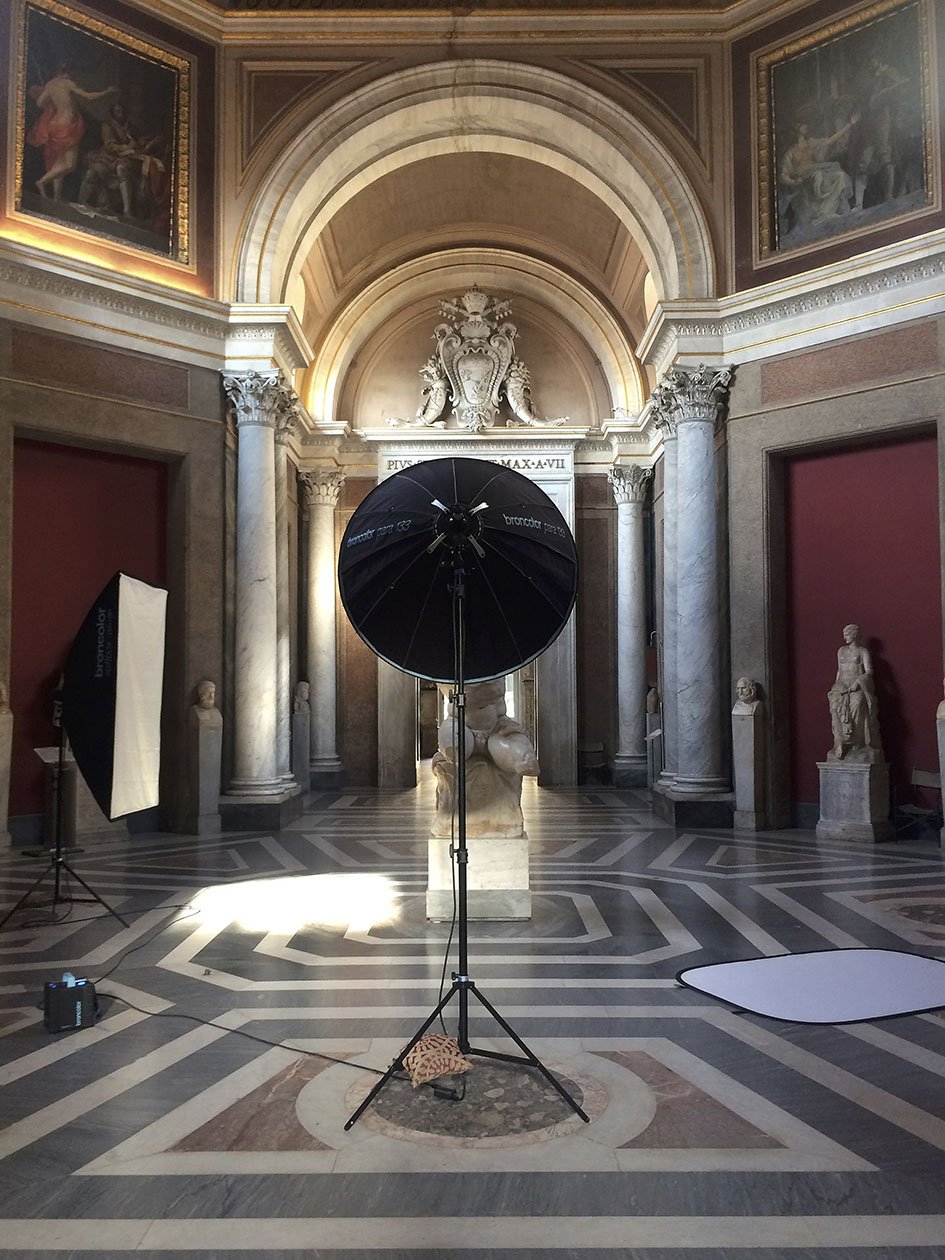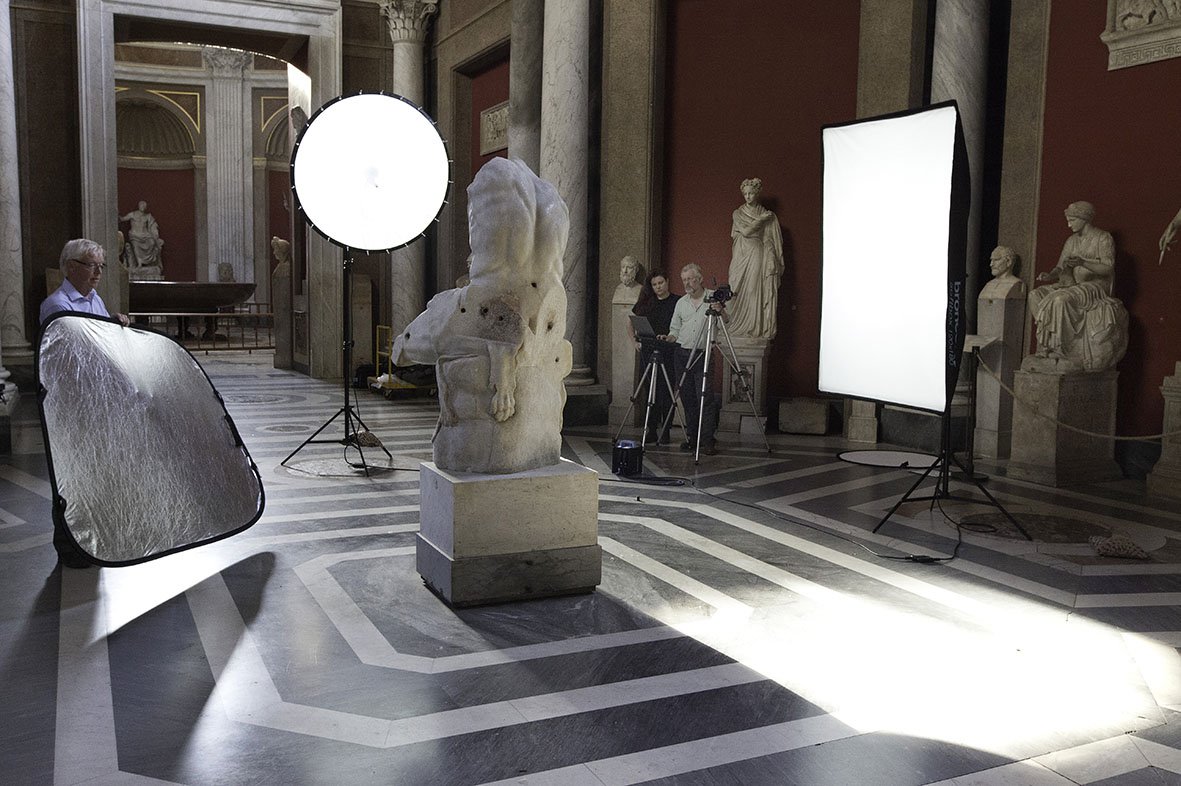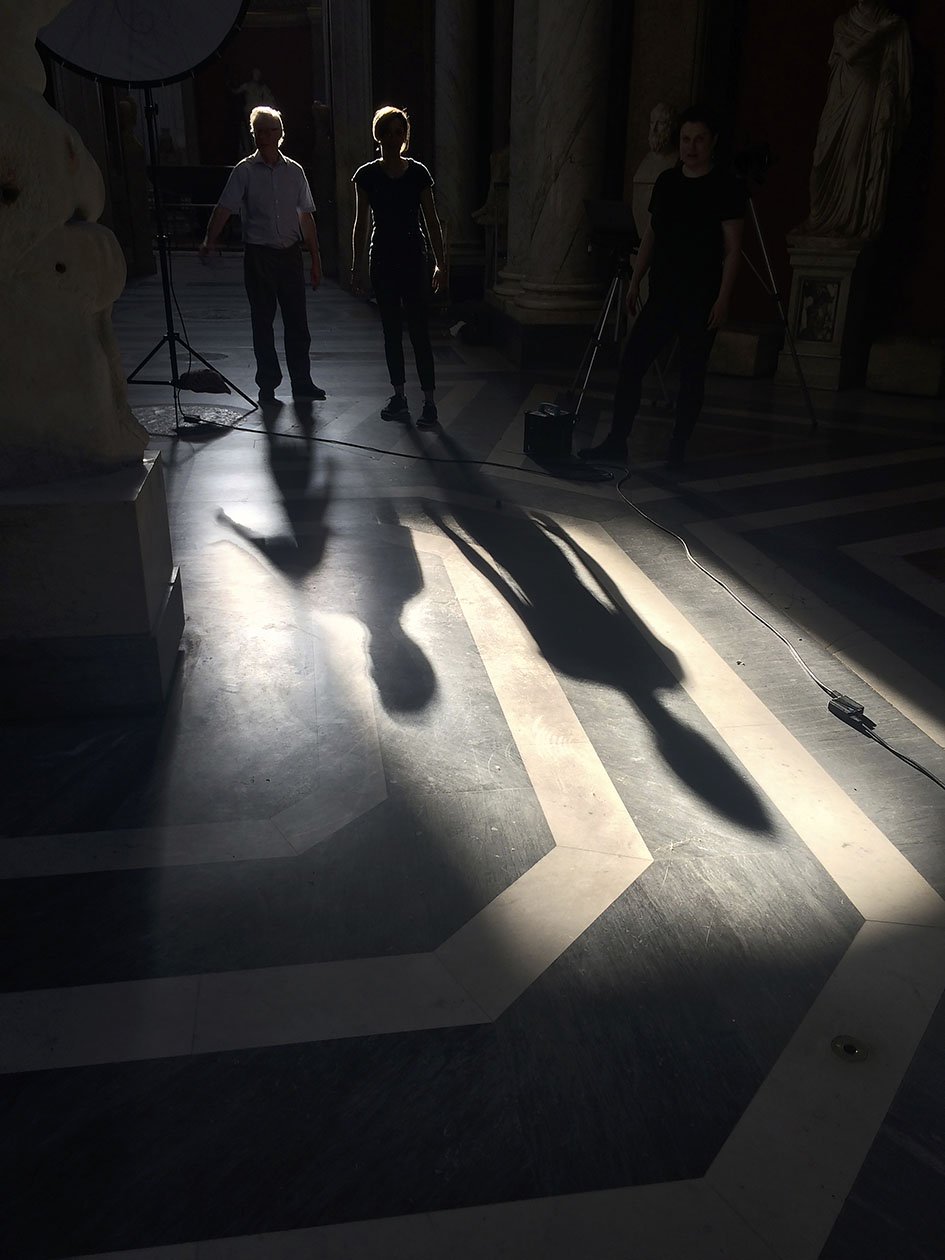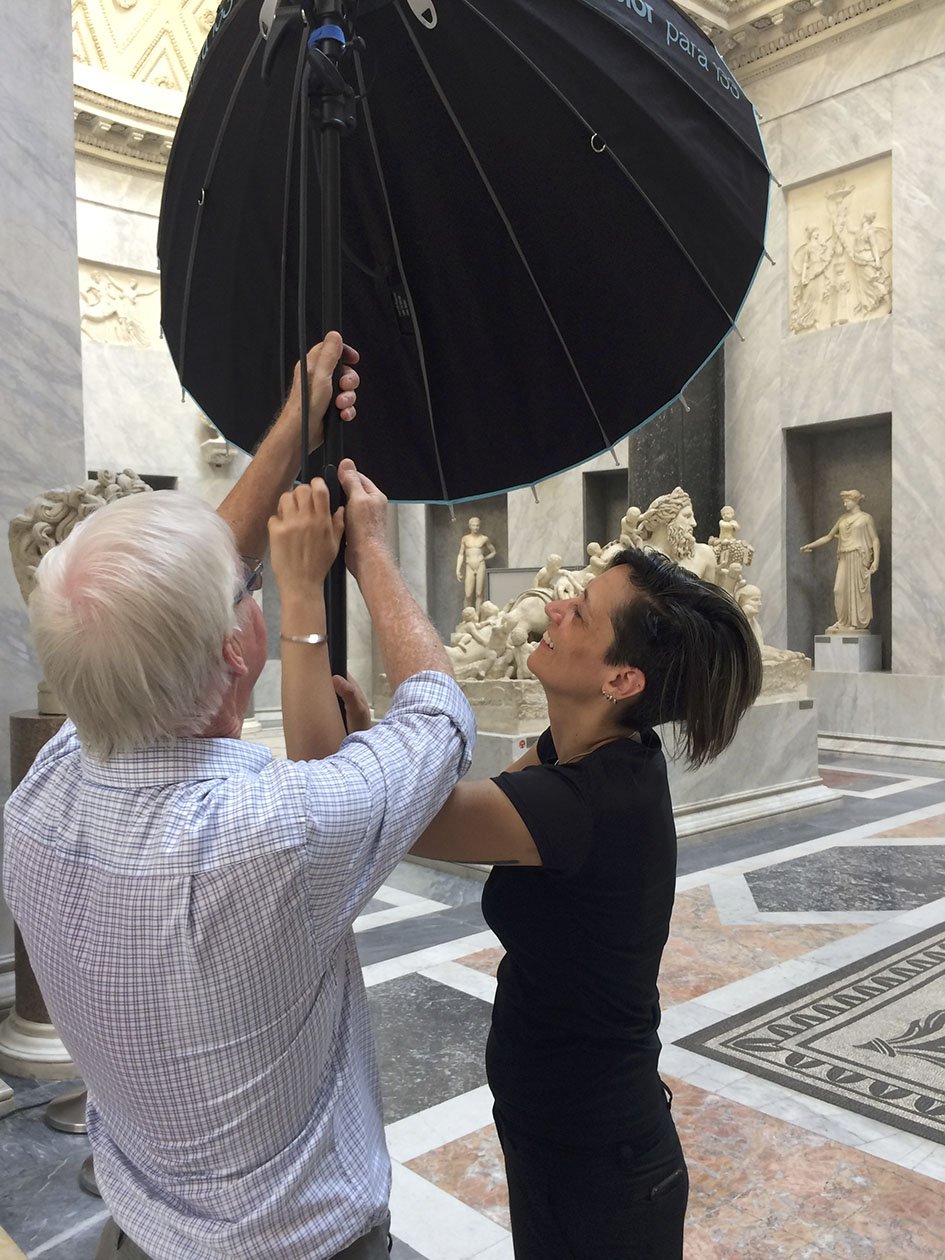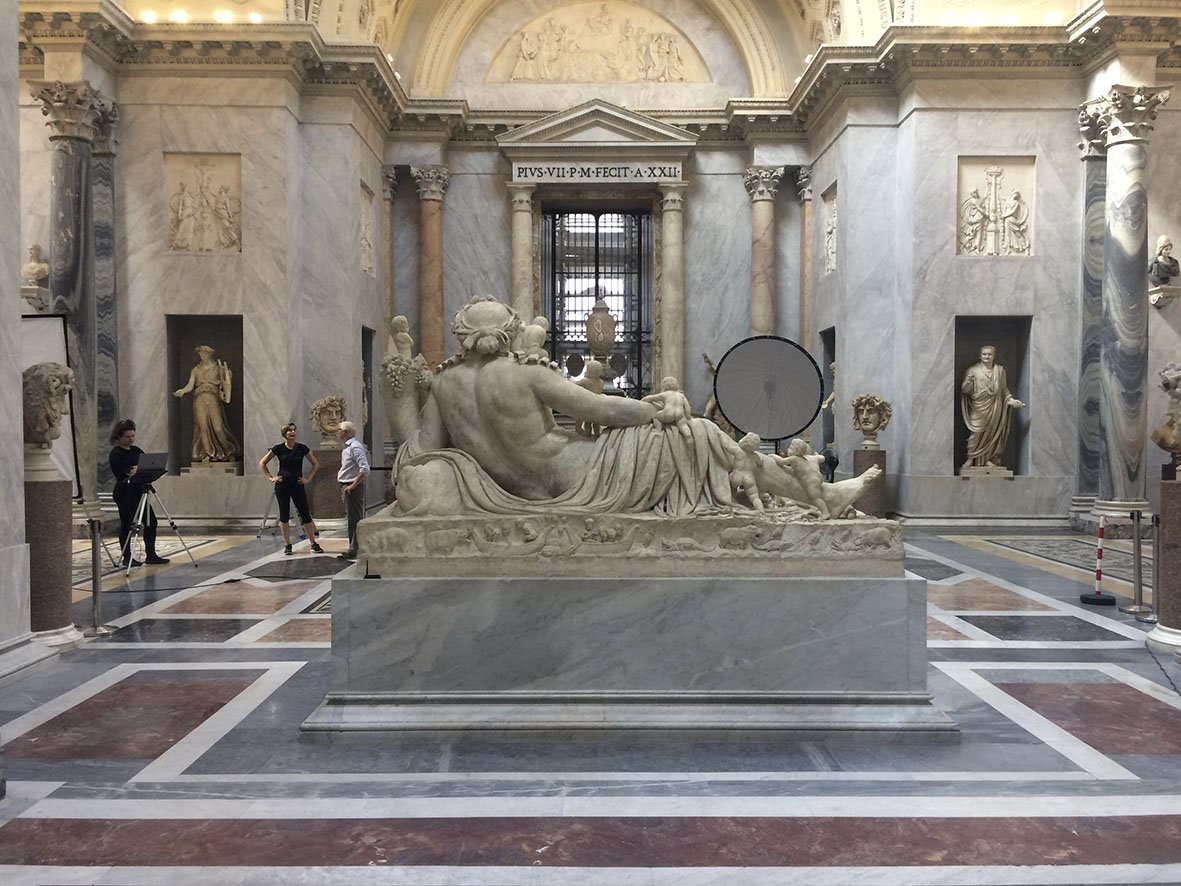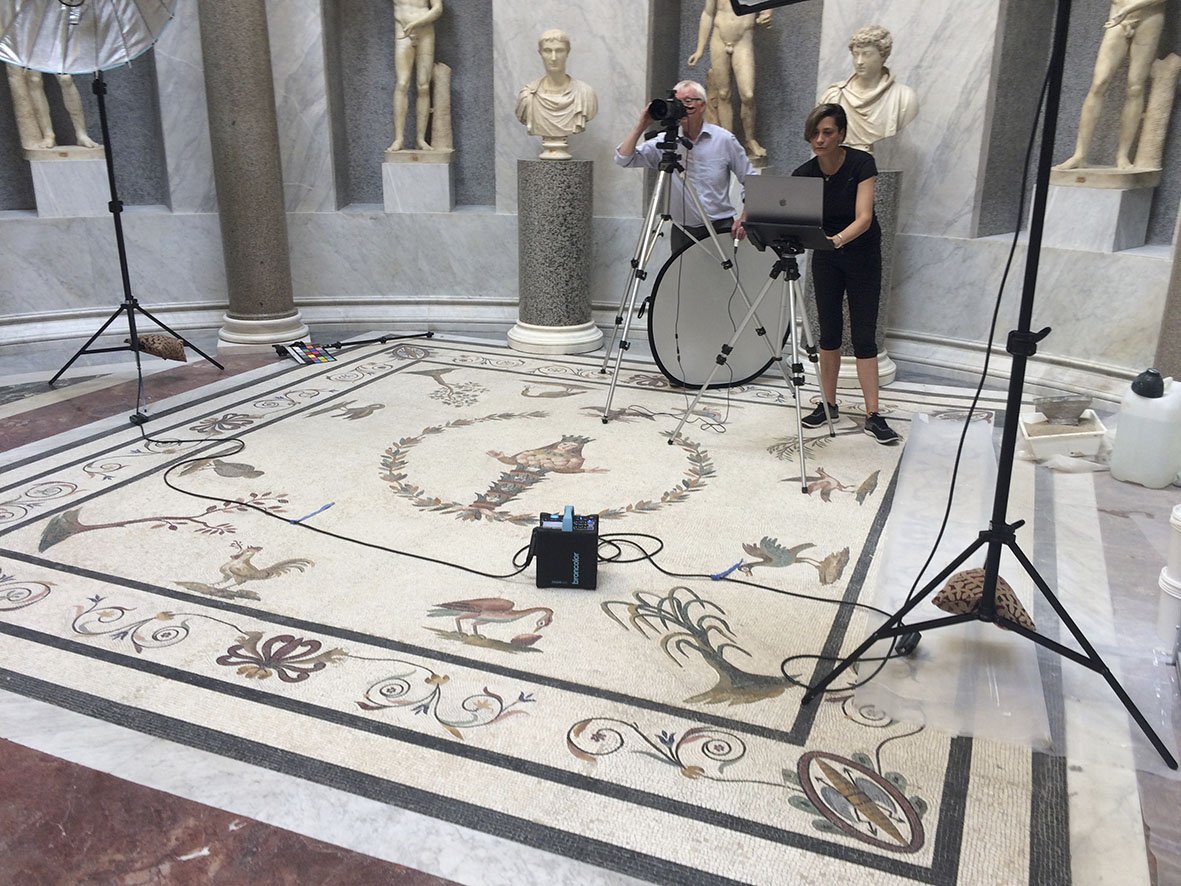In 2015 CHD Ltd., Directors Ken Jackson and James Stevenson, were asked by the late Hester Diamond to photograph classic antique sculpture for a new edition of “Taste & the Antique’. This itself was a classic book, first published in 1981 as; Taste and the Antique: The Lure of Classical Sculpture 1500-1900, by Francis Haskell and Nicholas Penny, now to be revised and extended by Adriano Aymonino and Eloisa Dodero. New photography of the sculptures discussed in this book, was a priority for Hester Diamond, who wonderfully supported and financed the project under her project Vistas.
We were fortunate in the project to be asked to photograph classical Greek and Roman sculpture in the Louvre, Uffizi, Prado, Capitoline, Munich Glyptotek, Archaeological Museum in Naples and the Vatican. The following is a report on the campaign we undertook in the Vatican in the summer of 2018.
When leaving the Vatican after photographing Venus Felix one evening, we were introduced to a member of staff walking through the galleries. He was described to us as the clavigero. He is the Keeper of the Keys. He told us he had responsibility for 2,797 keys and he was one member of a team of six clavigeri in the Vatican Museum. Every day they take three hours to unlock the museum in the morning and three hours in the evening to lock it again. The Vatican is a big museum!
Distance is a factor when photographing in old buildings such as the Vatican. We routinely carry 80kg of equipment in a total of seven bags, so the logistics of getting the equipment onto aeroplanes, into taxis and through many hundreds of metres of gallery space, up and down staircases and into lifts, is considerable.
On this campaign Ken Jackson and I had the assistance of two extra people, Dani Tagen and Thea Stevenson, so there were four of us, making the exercise a little easier. Some of the bags are what airlines call ‘oversize’, which means taking extra time and having longer discussions at airport check-ins. Over the last couple of years we have become familiar with the many different oversize baggage facilities around Europe.
The most significant part of the equipment we carry is the lighting. Finding often distant electrical points in old buildings has been a significant difficulty for museum photographers for many years. To solve this problem we use a Broncolor battery-powered flash lighting system. We carry two lithium ion battery packs and a full charge is sufficient for an entire photography session. Their Para reflector is astonishingly good for sculpture. It creates a wrap-around effect but still retains texture and shaping. For this reason power was never at issue in the Vatican galleries.
(Fig.1 Photographing Meleagar with our equipment bags in the foreground. Credit: James Stevenson)
When you arrive at the entrance to the Vatican Museum there is a scene of near-chaos. There are possibly thousands of people queuing in many queues, touts selling tours, vendors supplying water and ice-creams and security staff, some of them members of the Italian Army with automatic weapons. Fortunately, Dani speaks good Italian and, after approaching a member of the uniformed security staff, we were pleased to find that they were expecting us and they took us inside by a side entrance. They then called our liaison person, Filippo Petrignani, to collect us. After all of the negotiations over the last 18 months and worrying what our entrance to the museum would be like, it was most welcome that the co-ordination went so well. Rosanna di Pinto and her staff must be among the most experienced liaison people when it comes to working with the media. Not only were they well prepared but also relaxed and friendly and welcoming. Surprisingly, we did not need to sign in nor wear visitor badges. The print-outs of our passports which we had supplied in advance were sufficient identification for our visit.
(Fig.2&3 Entrance and exits doors to the Vatican Museum: Credit. Arianna Artusi)
Access to the galleries was by a wonderful old lift. This meant that we didn’t have to climb the large spiral ramp that leads from the entrance to the galleries. To make our task easier, Filippo had found a four-wheeled trolley. This saved us from having to carry the equipment on our shoulders and backs. As with all old buildings there are many tricks to getting around the building, odd slopes, back passageways and secret staff lifts, allowing you to get to new levels by avoiding many flights of stairs.
(Fig.4 Carrying our equipment through the Galleria dei Candelabri. Credit: Dani Tagen)
Rosanna had prepared a series of sessions for us, based on a time of three hours to photograph each sculpture. We had agreed this before our arrival but, from past experience during the project, we expected to be well in advance of this on many occasions. This itinerary worked well and we largely kept to this throughout the whole campaign.
(Fig.5&6&7&8 Working in the galleries after closing time. Credit: Thea Stevenson)
The Vatican closes to visitors at 6.00 pm but visitors tend to take quite a while leaving the museum. This is partly because of its size and the fact that visitors always see a new gallery that they may have missed. We arrived for our first session at 3.30 pm in the Gallery Braccio Nuovo and the intention was that this would be closed to the public for us to set up our equipment at 4.00 pm. However, for some reason this was not possible and we had to work in the gallery with the public still walking through. We erected Tensor barriers around our set, placed our equipment bags in a neat pile out of the way and worked slowly and carefully in order not to distract the visitors. There are times when photography can become a performance art and attracts as much attention as the works of art. Frequently people stopped to watch us work rather than look at the sculptures.
(Fig.9&10 Photographing Pudicity in the Braccio Nuovo Gallery when open to the public. Credit: Thea Stevenson)
he two pieces we photographed in the Braccio Nuovo were standing figures against the wall, Pudicity and Minerva. As the backs were inaccessible we were unable to photograph them in the round and the presence of the public did not interfere too much with our progress. The Braccio Nuovo is one of the main sculpture galleries in the Vatican and also includes the Nile, which we returned to photograph on a later occasion. There are many major pieces displayed there. All of the security staff who worked with us asked, “ Why aren’t you photographing Augustus? Isn’t it in your book?” We had no answer. *
(Fig.11 The sculpture of Augustus in the Braccio Nuovo Gallery. Credit: James Stevenson)
As with every other session of photography, regardless of the time of day, the weather was relentlessly hot and humid, around 35° C and 70% RH during the whole time of our visit to Rome. Sweating near priceless objects is a conservation hazard and you have to be careful that you do not drip onto the sculptures. We made sure that we that we had sufficient water with us, but this only added to our load. The heat made the photography quite exhausting and even the drink of Italian beer afterwards was welcome.
We undertook six sessions of photography in the Vatican and photographed in some of the world’s greatest galleries of sculpture. The Cortile Ottagono is one of these great spaces. As its name suggests it is an eight-sided gallery open to the sky with a colonnade around the sides.
There is a fountain in the centre, entrances on opposing sides and sculptures in each of the other six faces. We photographed four of these sculptures: Venus Felix, Hermes, Apollo Belvedere and the Laocoön. The Venus was relatively straightforward in a similar way to Pudicity and Minerva, the others more challenging. The Laocoön is a sculpture we had much looked forward to photographing. It is complex in nature with three figures with a large intertwining serpent. It is in a difficult space, and historically important. We had seen many copies of the sculpture on working visits to other museums around the world, from the Uffizi, the Rijksmuseum, Castle of the Knights on Rhodes and even in Rio de Janeiro, so we were familiar with it. The original, of course, is always the best and we felt privileged to have this opportunity.
(Fig.12 Time lapse film showing the photography of the Laocoön in the Cortile Ottagano. Credit: Thea Stevenson)
One shot that we were determined to achieve was of the back of the sculpture, a shot we had never seen made as a serious photograph. The space behind the sculpture is restricted so we were forced to use a shorter wide-angle lens than we would have liked. To reduce the distortion inherent in this type of lens, we used the centre rather than the whole image frame. Placing the lights into position was tricky, because of the restricted space, so all movement around the sculpture and equipment had to be slow and considered with everyone voicing their intentions before moving. Distinct roles and tasks are important in these situations so these are defined before starting. Of course by this time and so far into the project we had worked out a consistent method of working and each sculpture usually followed a defined pattern of approach. Power-pack in a regular position, light cables just so, computer and camera at the right height, step-ladders in the correct position to the camera and so on. In this way potential danger is minimised and the session made as safe as possible both for the team and for the object. We achieved a shot of the rear of the sculpture and look forward to the post-produced image to see this aspect of the sculpture in an original way.
(Fig.13&14 Photographing the back of the Laocoön. Credit: James Stevenson & CHD Ltd.)
Two of the sculptures, Hermes and the Apollo Belvedere, had restricted views because of conservation work taking place on the marble panels on either side of the sculptures. The panels which had been set up alongside the sculptures to protect the working space made it difficult to place our camera and lights in the way we would have ideally wanted, to match the rest of our images.
Just before moving to photograph the Apollo Belvedere, Rome was engulfed in a sudden thunderstorm. We had to wait for an hour while the Cortile Ottagano filled up with rainwater, drained away, and then was mopped down. It was interesting being inside a museum with rain coming into a ‘gallery’.
(Fig.14 Thunderstorm in the Cortile Ottagano. Credit: Thea Stevenson)
The Vatican galleries are primarily lit by daylight; high glass ceilings and high windows are common in many spaces. Strong beams of daylight can create unwelcome highlights on the marble. In order to minimise the effects of the sunlight falling onto an object in a way that would affect the quality of the photograph, care must be taken in balancing the power of the flash lights and the ambient daylight. There are occasions, however, when this balance is difficult to achieve, particularly when the sun is setting and coming into the gallery windows at a low angle. One such occasion was when photographing the Belvedere Torso and we found ourselves racing ahead of the moving sun in order to keep the selected views in shadow.
(Fig. 16&17&18 Bright sunshine falling onto the Belevedere Torso in the Sala delle Muse. Credit: James Stevenson)
We photographed thirteen sculptures at the Vatican, in six separate sessions, finishing with the monumental Nile in the Braccio Nuovo gallery, a large sculpture in the round which was pleasant to photograph because its display space is generous, allowing us easy access to all sides. Glancing down at the floor, we realised that the mosaic floor, over which we were walking and where all of our equipment was standing, is itself a late Roman artefact, a part of the fabric of the building.
(Fig.19&20&21 Photographing the Nile in the Braccio Nuovo gallery. Credit: James Stevenson)
After successfully completing the Nile and packing away all of our equipment, Dani asked the security warder supervising us, if we could see the Sistine Chapel. Visitors all week had been rushing through the galleries, almost ignoring the art on display just to see this space, one of the sights on the modern ‘Grand Tour’. Stephano, the warder, said he would be delighted to do so and we left our equipment safely in the gallery and followed him on a very long walk. During our work for “Taste and the Antique” we have had the privilege to visit great cultural spaces when they have been empty. As well as spending a day photographing in the Salle Tribunale at the Uffizi and a whole evening photographing the Venus de Milo at the Louvre, we have had ‘private’ views of the Botticelli Gallery, the Mona Lisa, Goya’s Black Paintings and now the Sistine Chapel. There were just four of us and Stephano in a space normally occupied by a couple of thousand people during the day.
(Fig.22&23 After-hours visit to the Sistine Chapel. Credit: James Stevenson)
During the hours when it is open the Vatican Museum is an overwhelming place for the public, it seems so busy and commercialised that its charm is often lost. After hours it becomes almost an intimate community like most major museums and galleries, with its dedicated staff who enjoy the privilege of working in such a wonderful place.
Taste & the Antique is due to be published by the end of 2023.
(Fig.24 The photographic team during the Vatican campaign. LtoR: Ken Jackson, James Stevenson, Thea Stevenson, Dani Tagen. Credit: Ken Jackson)
* The statue of Augustus was not excavated until 1863, hence it does not share the same influence on western taste as those sculptures featured in ‘Taste and the Antique’ which were mainly re- discovered during the Renaissance.
James Stevenson Ken Jackson CHD Ltd.













